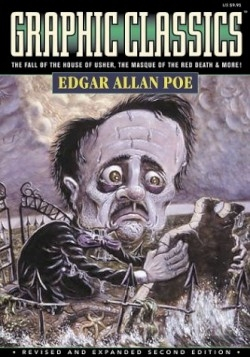Graphic Classics
Edgar Allan Poe
“Poe was a madman,” says Joe R. Lansdale in his introduction to this second edition of adaptations and illustrations of Poe’s work. He “was darker, and far more savage” than the movies made from his tales. While that darkness and savagery are still not matched in the illustrations in this book (as Lansdale says, “No one can generate that absolute darkness better than he”), the artists are nonetheless a diverse and talented group.
In stories and poems that include “The Tell-Tale Heart,” “The Fall of the House of Usher,” “The Bells,” and “The Cask of Amontillado,” a bevy of artists such as Spain Rodriguez, John Coulthart, Juan Gomez, Rick Geary, and Lisa K. Weber have done their best to evoke the dark and moody atmosphere that colored most of Poe’s works. Some of the adaptations are frame-by-frame retellings in classic comic book style; others are illustrations that accompany the full text of a story or poem.
The artists’ renditions of these works range from delicate (Weber, for “Hop-Frog,” whose characters are at once jeweled and grotesque, finely drawn and shaded) to black and heavily inked (Milton Knight, for “Never Bet the Devil Your Head,” in which he captures the atmosphere of a carnival sideshow in both image and feel) to classic engraving (John Coulthart, for “The Haunted Palace,” in which the delicately beautiful and the disturbing vie for the eye) to technical (J. B. Bonivert, for “The Raven,” in which images and words clash with unfortunate results, although the artwork is quite eye-catching, with lots of black and many round shapes).
The most amusing artwork is found in Roger Langridge’s illustrated version of “Eldorado,” in which a knight sings in the first panel, much to the distress of his horse; as knight and horse age during their quest, the horse goes from sulky to toothless, aged, and weary even as the knight goes from determined to hapless to resigned. Rick Geary’s policemen are perfectly officious as they sit and listen to the narrator of “The Tell-Tale Heart.” And Stanley W. Shaw’s interpretation of “The Masque of the Red Death” juxtaposes strong, heavy black specters among throngs of more delicately detailed merrymakers at that ill-fated party.
The cover, by Skot Olsen, is spectacular, its colors accentuating myriad catastrophes, from fire and flood to storm and destruction, with a caricature of Poe himself holding a tombstone, surrounded by wrought-iron fence; on the gates behind him can be read parts of the name “Annabelle Lee.”
Poe lovers won’t want to discard their complete works editions, but will want to add this to their collections.
Disclosure: This article is not an endorsement, but a review. The publisher of this book provided free copies of the book to have their book reviewed by a professional reviewer. No fee was paid by the publisher for this review. Foreword Reviews only recommends books that we love. Foreword Magazine, Inc. is disclosing this in accordance with the Federal Trade Commission’s 16 CFR, Part 255.

